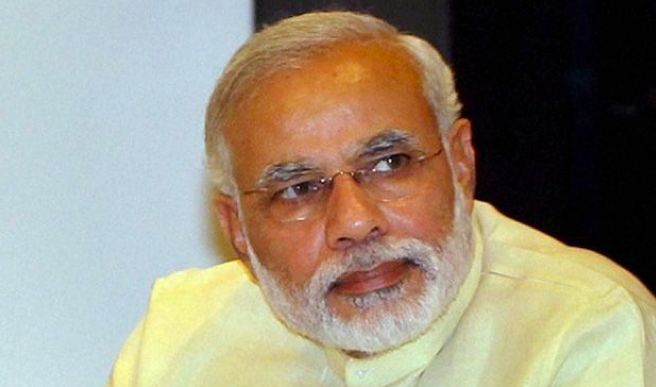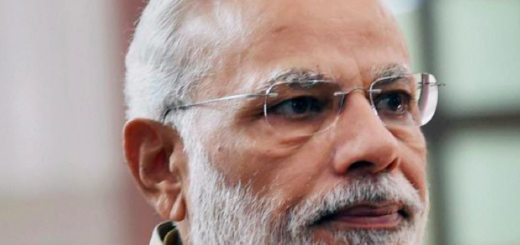Polinomics: The writing on the wall (Prophets of doom for Modi?)

Prime Minister Narendra Modi manages his personal Facebook and Twitter Account. (Representational Image)Deccan Chronicle, Paranjoy Guha Thakurta | December 29, 2015
(Note: The forthright criticism of Paranjoy Guha, sounds frightening: “Best-selling author Chetan Bhagat has presciently anticipated the BJP’s “worst nightmare” in 2019 — a defeat by a “maha federal front”. Well wishers of Modi do not want to see it happen and even critics of Modi himself, based on his performance as Gujarat CM and India’s globe trotting PM for the last one year will find it hard to say that Modi will not see the writing on the wall and will not bounce back by hook or crook. But both will readily admit that his  popularity has plummeted beyond all guessing. Modi himself is becoming more inclusive in words and deeds. To make or break a democratically elected government we need an educated electorate which India lacks today. So it will take a lot of time to see an enlightened government at the helm of affairs in India. james kottoor, editor)
popularity has plummeted beyond all guessing. Modi himself is becoming more inclusive in words and deeds. To make or break a democratically elected government we need an educated electorate which India lacks today. So it will take a lot of time to see an enlightened government at the helm of affairs in India. james kottoor, editor)
One of the most notable aspects of 2015 was the rapidity with which Prime Minister Narendra Modi’s popularity plummeted, surprising his most trenchant critics and political opponents as well as his diehard supporters and ardent followers. Whether he will be able to refurbish his sagging image during 2016 is uncertain given his firm loyalty to the RSS. From his public utterances, it is clear that Mr Modi realises that he has to be seen as “inclusive”. But his government’s actions have not elicited confidence in the country’s minorities, especially Muslims.
On the economic front, the year gone by has been extremely lucky for India with prices of crude oil collapsing. But the year ahead is unlikely to be tranquil. The world economy is fraught with uncertainty. Within the country, investments, especially from the private sector, are refusing to pick up. Exports have crashed. The revised but questionable estimates of gross domestic product indicate that India is the fastest growing among major economies of the world, but these growth rates will slow down. In February, the Economic Survey had claimed that the economy had “reached a sweet spot” which was “rare in the history of nations” to “finally be launched on a double-digit, medium-term growth trajectory”. In December, the chief economic adviser Arvind Subramanian, scaled down his own projections of GDP growth for the current financial year from 8.1-8.5 per cent to 7-7.5 per cent. Few will be surprised if the GDP growth rate in 2016-17 does not exceed six per cent.
Public sector banks are groaning under the burden on unpaid loans as many large private corporate entities find it difficult to expand capacities in the face of sluggish demand. The crisis in the agricultural sector has deepened and widened because of two successive years of inadequate rainfall, as a result of which drought-like conditions are prevailing across half the geographical area of India. What is worse for the Modi government is that jobs are not being created in adequate numbers and inflation is threatening to rise. Even now, many in the government seem most reluctant to accept the fact that the trade and manufacturing-driven “Gujarat model of development” led by “benevolent” private entrepreneurs is just not applicable to most parts of India. The “minimum government” mode is disastrous when it comes to much of northern and eastern India. The coalition led by Nitish Kumar in Bihar would not have rendered such a resounding defeat to the Bharatiya Janata Party and the National Democratic Alliance if the Gujarat model was indeed so attractive.
The resounding defeat of the BJP in Delhi in February has revealed the limitations of “personalisation” of politics that worked for Mr Modi in the 2014 general elections. When individuals are made out to be larger than life, the sword becomes double-edged and cuts both ways. Thus, Arvind Kejriwal prevailed in the contest over Kiran Bedi as did Mr Kumar, in Bihar, over Mr Modi. The BJP didn’t learn any lessons from the electoral outcome in the capital and tried the same set of tactics in Bihar, only to be rebuffed. On foreign policy, Mr Modi was successful in breaking the cycle of negative news with his surprise visit to Pakistan. However, he has an extremely difficult task ahead of him in countering growing anti-India sentiments in Nepal. The “rock star” treatment accorded to the Prime Minister by his non-resident Indian supporters will not make his hassles at home disappear. And one of the biggest problems he faces — a problem which is bound to intensify in 2016 — is dealing with internal dissent.
The attacks “from within” aimed at Union finance minister Arun Jaitley and BJP president Amit Shah are surely not going to abate. That’s an inevitable result of concentrating too much power in the hands of two individuals. The BJP has suspended its MP from Bihar, Kirti Azad, for his criticism of the role played by Mr Jaitley in the Delhi and District Cricket Association. But will the party also act against Shatrughan Sinha, R.K. Singh and Bhola Singh, not to mention the “angry old men” L.K. Advani, Murli Manohar Joshi, Shanta Kumar and Yashwant Sinha for “anti-party” activities? More importantly, will Mr Modi break his silence on the incendiary statements issued from time to time by some of his ministers and party worthies such as Mahesh Sharma, Sadhvi Niranjan Jyoti, Yogi Adityanath and Giriraj Singh? The selective silence of our loquacious PM is indeed deafening. Two of the best bits of unsolicited advice to Mr Modi have come from people he can certainly not consider his critics.
Having been unsuccessful in her attempt to consume beef in a Delhi restaurant recently, columnist Tavleen Singh has told the Prime Minister in no uncertain terms that he “must publicly demand action against BJP leaders in Dadri whose relations were involved in the killing of Mohammad Akhlaq”. Best-selling author Chetan Bhagat has presciently anticipated the BJP’s “worst nightmare” in 2019 — a defeat by a “maha federal front”. He added, “This wasn’t a real possibility a year ago, but it is now”. Need one say more? The writing on the wall is clear. In 2016, even as Mr Modi will try to reinvent himself as an inclusive, statesman-like leader, the chances of him succeeding do not appear particularly bright.
















